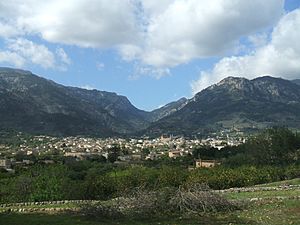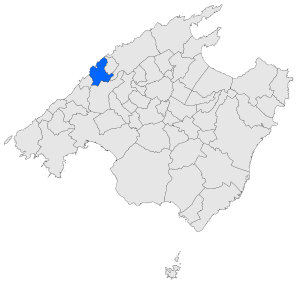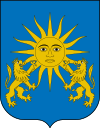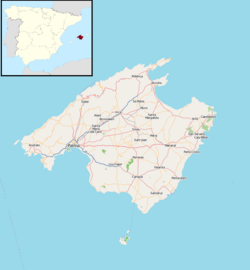Sóller facts for kids
Quick facts for kids
Sóller
|
||
|---|---|---|

Panorama of Sóller from the north
|
||
|
||

Map of Sóller in Mallorca
|
||
| Country | ||
| Autonomous community | ||
| Province | Balearic Islands | |
| Island | Majorca | |
| Comarca | Serra de Tramuntana | |
| Judicial district | Palma de Mallorca | |
| Area | ||
| • Total | 42.80 km2 (16.53 sq mi) | |
| Elevation | 59 m (194 ft) | |
| Population
(2018)
|
||
| • Total | 14,041 | |
| • Density | 328.06/km2 (849.67/sq mi) | |
| Demonym(s) | Solleric, Sollerica | |
| Time zone | UTC+1 (CET) | |
| • Summer (DST) | UTC+2 (CEST) | |
| Postal code |
07100
|
|
| Official language(s) | Catalan and Spanish | |
Sóller is a beautiful town and municipality located on the island of Mallorca, Spain. It sits in a large, bowl-shaped valley near the northwest coast. About 14,000 people live here. The town is about 3 kilometers (2 miles) inland from its port, Port de Sóller. The valley also includes the village of Fornalutx and smaller areas called Biniaraix and Binibassi. A special tram, the Tranvía de Sóller, connects Sóller to its port.
Contents
Discovering Sóller
Sóller is connected to Palma, the capital of Mallorca, by a historic railway. There is also a highway with a tunnel. The railway, called the Ferrocarril de Sóller, was built using money from selling oranges and lemons. It was finished in 1911. Another road, the Andratx-Pollença highway, also goes through the valley.
Today, Sóller's economy mostly relies on tourism. Many visitors come here, and people from other countries live here. However, farming is still important, especially growing citrus fruits like oranges and lemons, and olives. Sóller is special because it is surrounded by the Serra de Tramuntana mountains. This made it a bit isolated from other towns on the island. Because of this, it was easier for Sóller to trade with French merchants who arrived by sea.
Exploring Sóller's Main Sights
The main part of Sóller is the Plaça Constitució. This square is surrounded by cafés and has plane trees and a fountain in the middle. The tram passes right through the Plaça. The main tram station has been updated to include a museum with art by Picasso and Joan Miró.
Important Buildings
The church of Sant Bartomeu (Saint Bartholomew) is on the east side of the Plaça. Next to it are the ajuntament (which means town hall) and the Banco de Sóller. The bank building is a remarkable example of Modernisme architecture from 1912. It has cool ironwork and was designed by Joan Rubió i Bellver, a Catalan architect who followed Antoni Gaudí. The bank was started in 1889 with money from people who had left Sóller, made a lot of money, and then returned.
The church itself is very old, dating back to before 1236. The inside of the church was largely rebuilt in the Baroque style between 1688 and 1733. The belltower, called a campanar, fits well with its neo-gothic design. The impressive front of the church was also built by Joan Rubió in 1904.
Town Layout and Gardens
The old streets of Sóller follow a plan from Islamic times. They are lined with historic houses from the 16th to 18th centuries. The town also has a covered market and a fast-flowing river with several bridges. Sóller is also known for the beautiful houses built in the early 20th century. These were built by people who returned wealthy to the town after living abroad. Many of these houses, especially on the Gran Via, show the fin de siècle Art Nouveau styles popular in France.
On the edge of town, you can find the famous Jardí Botanic (which means botanical garden). This garden features plants from the Balearic Islands and other Mediterranean islands. Inside a Modernista mansion in the garden is El Museu Balear de Ciències Naturals (The Museum of Balearic Natural Sciences).
Exciting Events in Sóller
Sóller hosts several fun and interesting festivals throughout the year:
- Firó Festival: This is Sóller's most important festival. It celebrates a time on May 11, 1561, when Moorish pirates attacked the town. During the festival, people reenact four battles. Locals dress up as turbaned pirates or in traditional clothes and act out mock battles to push back the invaders. There are also fireworks!
- Sa Mostra Folklore Festival: Since 1980, Sóller has hosted this week-long international folklore festival. It usually takes place between May and July. It was started by a traditional dance group called "Aires Sollerics."
- St. Bartholomew's Celebration: In August, Sóller celebrates its patron saint, St. Bartholomew. This festival includes bonfires and exciting "devilish" masquerades called the "correfoc" (which means "fire-run"). Local groups invade the town square, creating an allegory of hellfire. Then, the "correaigua" ("water-run") happens, where the local fire department sprays water to cool down the crowds.
- Day of the Three Wise Kings: Every January, Sóller celebrates Epiphany as the Day of the Three Wise Kings. Processions of the Magi (the Three Wise Kings) go from the Port to the town square. They throw sweets to crowds of excited children. Traditionally, this holiday is even more popular than Christmas on December 25th in Sóller.
Museums to Visit
Sóller has several museums where you can learn more about the area:
- Museo de la Mar: This is a maritime museum, which means it's all about the sea. It's located in the Oratorio de Santa Caterina d'Alexandria, a building from the 13th century, in Port de Sóller.
- Museu de Sóller: Casal de Cultura: This museum is an ethnographic museum and art gallery. It shows how people lived in the past and displays art. It's in a building from 1640 on Calle de Sa Mar, 13 in Sóller.
- Can Prunera: Also known as Can Magraner, this is a modernist townhouse museum built in 1911. You can find it on Calle de la Lluna 86 y 90 in Sóller.
- Museo de Ciencias Naturales y Jardín Botánico: This museum, opened in 1985, is the local botanical garden and natural sciences museum. It's located on the Carretera al Puerto de Sóller.
Notable People from Sóller
- Gregorio Bausá (1590-1656), a painter
- Albert Hauf (born 1938), a philologist (someone who studies language in historical texts)
- Joan Miquel Oliver (born 1974), a musician
- Tuni (born 1982), a footballer
- Colm Meaney (born 1953), an Irish actor
Images for kids
See also
 In Spanish: Sóller para niños
In Spanish: Sóller para niños










